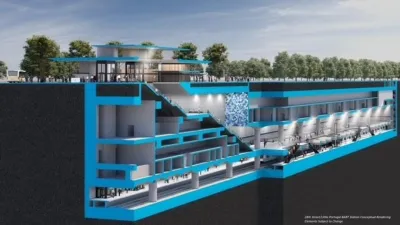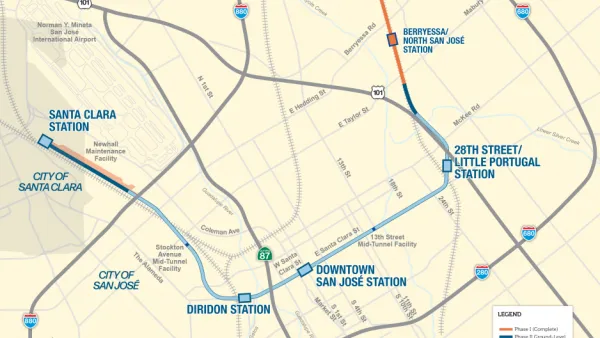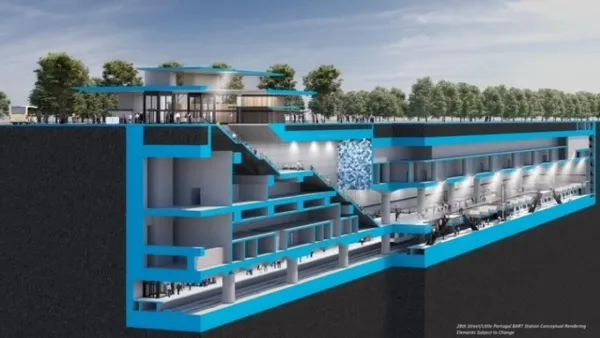Critics panned new renderings for the 28th Street/Little Portugal station on the planned BART extension into San Jose.

"Public transit advocates are pillorying plans for the $6.9 billion extension of BART service through downtown San Jose over station designs that require passengers to descend up to 90 feet to get from the street to their trains," writes Nico Savidge.
"On Twitter, dozens of replies and quote-tweets have panned a Monday post from the Santa Clara Valley Transportation Authority(VTA), which is building the BART extension, criticizing a rendering of the planned 28th Street/Little Portugal subway station," according to Savidge.
Here is the Twitter post in question, which includes a link to an article on the VTA website announcing two recent milestones for Phase II of the extension project:
What's happening with #BART to Downtown #SanJose, you ask? We answer!https://t.co/JexUke6U6X #HelloVTA #SolutionsThatMoveYou pic.twitter.com/8TrxVZZ5al
— BART Silicon Valley (@bartsv) May 17, 2021
Savidge also explains why the station was planned for such depths beneath the city:
One reason is that when VTA planned the extension, it faced a choice between shallower, more conventional stations that would require tearing up sections of Santa Clara Street for years at a time — which downtown businesses opposed — or a new subway building method pioneered in Spain that promised to minimize disruptions at ground level by tunneling deeper underground. VTA chose the latter.
Moreover:
VTA spokeswoman Bernice Alaniz emphasized that business disruptions weren’t the only factor, however — soil conditions, the need to work around underground utilities and a desire to avoid severing VTA’s light rail line also factored into the decision to tunnel deeper.
The article offers additional details of the thinking behind the station design, in addition to some of most scathing quips from the social media response to the renderings.
As for the Phase II milestones that were originally the purpose of the Twitter post, the aforementioned article on the VTA website, written by Bernine Alaniz, reports that Phase II "has advanced to the final step in the application process for the Federal Transit Administration’s Expedited Project Delivery Pilot Funding Program (EPD), and selected three joint ventures to submit proposals on the estimated $2 billion track and tunnel work contract." The VTA is seeking $1.735 billion in federal funds through the EPD Program to finalize funding for the project.
FULL STORY: Twitter roasts San Jose BART extension plans: ‘Journey to the center of the Earth’

National Parks Layoffs Will Cause Communities to Lose Billions
Thousands of essential park workers were laid off this week, just before the busy spring break season.

Retro-silient?: America’s First “Eco-burb,” The Woodlands Turns 50
A master-planned community north of Houston offers lessons on green infrastructure and resilient design, but falls short of its founder’s lofty affordability and walkability goals.

Delivering for America Plan Will Downgrade Mail Service in at Least 49.5 Percent of Zip Codes
Republican and Democrat lawmakers criticize the plan for its disproportionate negative impact on rural communities.

Test News Post 1
This is a summary

Test News Headline 46
Test for the image on the front page.

Balancing Bombs and Butterflies: How the National Guard Protects a Rare Species
The National Guard at Fort Indiantown Gap uses GIS technology and land management strategies to balance military training with conservation efforts, ensuring the survival of the rare eastern regal fritillary butterfly.
Urban Design for Planners 1: Software Tools
This six-course series explores essential urban design concepts using open source software and equips planners with the tools they need to participate fully in the urban design process.
Planning for Universal Design
Learn the tools for implementing Universal Design in planning regulations.
EMC Planning Group, Inc.
Planetizen
Planetizen
Mpact (formerly Rail~Volution)
Great Falls Development Authority, Inc.
HUDs Office of Policy Development and Research
NYU Wagner Graduate School of Public Service





























